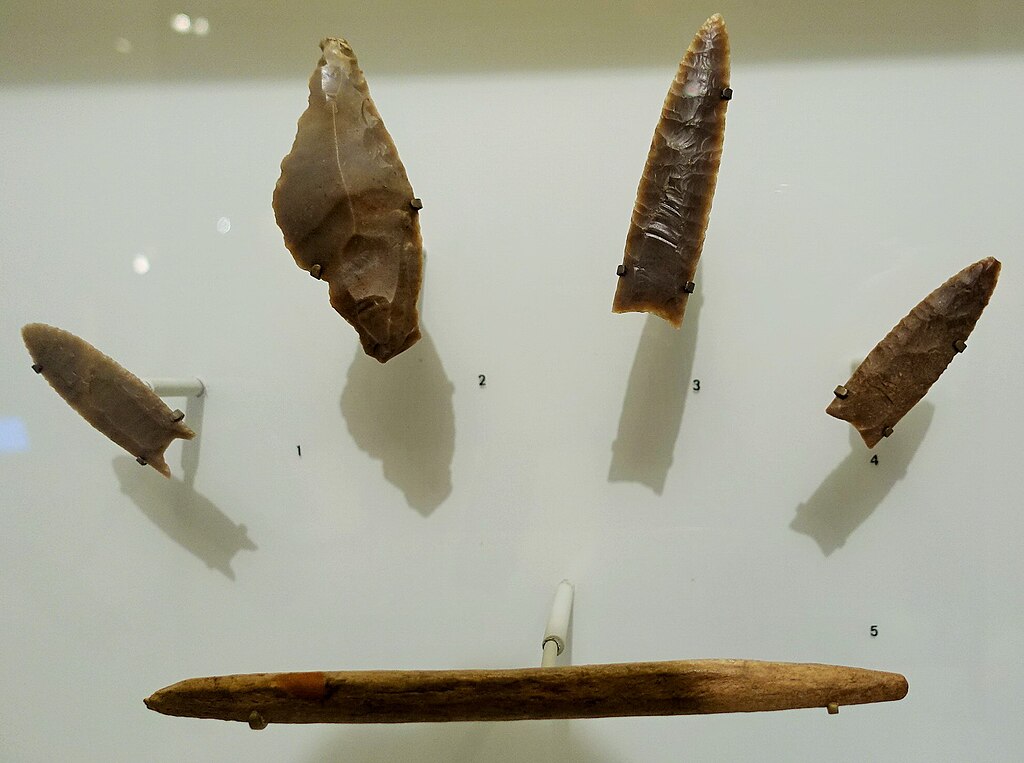
These “Clovis Weapons and Tools” are ancient tools that are over 10,000 years old. The Clovis culture was based initially around the current-day Clovis, New Mexico, US.
The Clovis culture is a prehistoric Paleo-Indian culture, named after the area where the stone tools discovered in the 1920s and 1930s.
The Clovis culture appeared around 11,500–11,000 years ago, at the end of the last glacial period.
This Paleo-Indian culture is characterized by the manufacture of “Clovis points” and distinctive bone and ivory tools. Clovis people are considered to be the ancestors of most of the indigenous cultures of the Americas.
The historical objects above have been named and dated as follow:
- Folsom Projectile Point – ca 9,000 – 8,000 BC
- Clovis Side Scraper-on-Blade – ca 11,050 – 10,800 BC
- Clovis Projectile Point – ca 11,050 – 10,800 BC
- Clovis Projectile Point – ca 11,050 – 10,800 BC
- Clovis Spear Foreshaft – ca 11,050 – 10,800 BC
These objects were recovered in near several complete mammoth skeletons and species of extinct bison. These objects confirm that people inhabited North America as long as 12,000 years ago.
Clovis points are the characteristically-fluted projectile points. A Clovis projectile point is created by using bifacial percussion flaking, which means that each face is flaked on both edges.
Clovis points are thicker than the typically thin later-stage Folsom points. Whether the points were knife blades or spear points is not known.
Folsom points were a later development and had a distinct form of chipped stone projectile points.
The points have edges that were finely worked into a symmetrical, leaf-like shape with a concave base and wide, shallow grooves running almost the entire length of the point.
The discovery of the Clovis artifacts began when a cowboy found an ancient bison skeleton in 1908 after a flash flood. The site was then excavated in 1926, near Folsom, New Mexico.
This was the location of the first find in its original place, Folsom. This confirmation of an early human presence in the Americas inspired the interest to look for further evidence of early humans.
In 1929, the Clovis site was discovered near the Blackwater Draw in eastern New Mexico. The best-documented evidence of the Clovis complex was collected and excavated between 1932 and 1937.
Clovis Weapons and Tools
- Title: Clovis Weapons and Tools
- Providence: New Mexico, Blackwater Draw, Mammoth Pit, Clovis
- Culture Area: Greater Southwest
- Period: Paleo-Indian
- Date Made: 9000 BC
- Technique: Chipped
- Dimensions: L: 11.1cm; W: 2.7cm
- Museum: Penn Museum
Topper Tools from Clovis Site
A Tour of the Pennsylvania Museum of Archaeology and Anthropology
- Marble Portrait of Agrippina the Elder
- Herm of Herakles and Hermes
- Marble head of Emperor Caracalla
- Cult Statue Head of Diana
- Wine Transport Amphoras
- Greenstone Mask
- Egyptian Stela Fragment
- Sumerian Cone or Clay Nail
- Clovis Weapons & Tools
- Mayan Altar
- Shawabti of King Senkamanisken
- Coptic Pendant Crosses
- Jar Handles with Judean “Royal Stamp”
- Historical Objects of the Penn Museum
Ice Age and Clovis Culture
A Tour of the Top Museums in the USA
- Museums in New York
- Museums in Washington, D.C.
- Museums in Boston
- Museums in Los Angeles
- Museums in San Francisco
- Museums in Chicago
- Museums in Cleveland
- Museums in Philadelphia
- Museums in Wilmington
- Museums in Houston
- Museums in Honolulu
- Museums in Columbus
- Museums in New Haven
- Museums in Baltimore
- Museums in Massachusetts
- Museums in Buffalo, New York
- Museums in Fort Worth, Texas
- Museums in Detroit
- Museums in St. Louis
- Museums in Indianapolis
- Museums in Denver
- Museums in Dallas
- Museums in Cincinnati
Pre-Clovis Archaeology Along the Savannah River
~~~
“We will be known forever by the tracks we leave.”
– Dakota Proverb
~~~
Photo Credit: GM
Popular this Week








 Sponsor your Favorite Page
Sponsor your Favorite Page SEARCH Search for: Search Follow UsJoin – The JOM Membership Program
Sponsor a Masterpiece with YOUR NAME CHOICE for $5
Share this:
- Tweet
